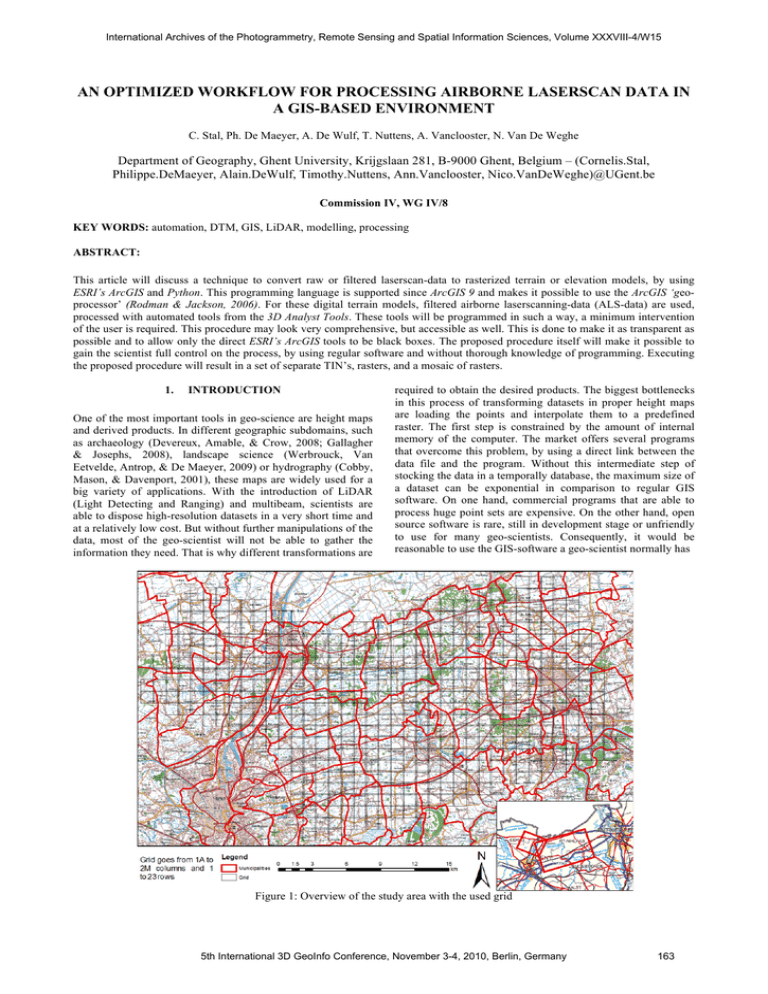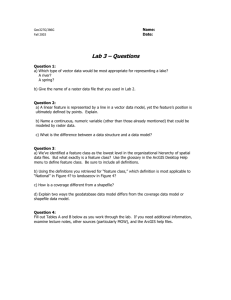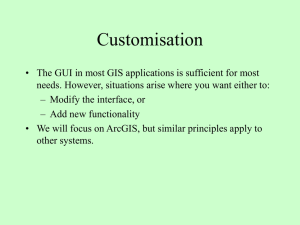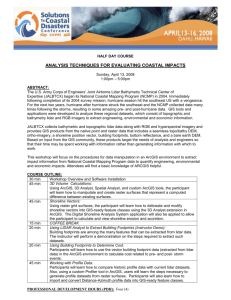Document 11869977
advertisement

International Archives of the Photogrammetry, Remote Sensing and Spatial Information Sciences, Volume XXXVIII-4/W15 AN OPTIMIZED WORKFLOW FOR PROCESSING AIRBORNE LASERSCAN DATA IN A GIS-BASED ENVIRONMENT C. Stal, Ph. De Maeyer, A. De Wulf, T. Nuttens, A. Vanclooster, N. Van De Weghe Department of Geography, Ghent University, Krijgslaan 281, B-9000 Ghent, Belgium – (Cornelis.Stal, Philippe.DeMaeyer, Alain.DeWulf, Timothy.Nuttens, Ann.Vanclooster, Nico.VanDeWeghe)@UGent.be Commission IV, WG IV/8 KEY WORDS: automation, DTM, GIS, LiDAR, modelling, processing ABSTRACT: This article will discuss a technique to convert raw or filtered laserscan-data to rasterized terrain or elevation models, by using ESRI’s ArcGIS and Python. This programming language is supported since ArcGIS 9 and makes it possible to use the ArcGIS ‘geoprocessor’ (Rodman & Jackson, 2006). For these digital terrain models, filtered airborne laserscanning-data (ALS-data) are used, processed with automated tools from the 3D Analyst Tools. These tools will be programmed in such a way, a minimum intervention of the user is required. This procedure may look very comprehensive, but accessible as well. This is done to make it as transparent as possible and to allow only the direct ESRI’s ArcGIS tools to be black boxes. The proposed procedure itself will make it possible to gain the scientist full control on the process, by using regular software and without thorough knowledge of programming. Executing the proposed procedure will result in a set of separate TIN’s, rasters, and a mosaic of rasters. 1. INTRODUCTION One of the most important tools in geo-science are height maps and derived products. In different geographic subdomains, such as archaeology (Devereux, Amable, & Crow, 2008; Gallagher & Josephs, 2008), landscape science (Werbrouck, Van Eetvelde, Antrop, & De Maeyer, 2009) or hydrography (Cobby, Mason, & Davenport, 2001), these maps are widely used for a big variety of applications. With the introduction of LiDAR (Light Detecting and Ranging) and multibeam, scientists are able to dispose high-resolution datasets in a very short time and at a relatively low cost. But without further manipulations of the data, most of the geo-scientist will not be able to gather the information they need. That is why different transformations are required to obtain the desired products. The biggest bottlenecks in this process of transforming datasets in proper height maps are loading the points and interpolate them to a predefined raster. The first step is constrained by the amount of internal memory of the computer. The market offers several programs that overcome this problem, by using a direct link between the data file and the program. Without this intermediate step of stocking the data in a temporally database, the maximum size of a dataset can be exponential in comparison to regular GIS software. On one hand, commercial programs that are able to process huge point sets are expensive. On the other hand, open source software is rare, still in development stage or unfriendly to use for many geo-scientists. Consequently, it would be reasonable to use the GIS-software a geo-scientist normally has Figure 1: Overview of the study area with the used grid 5th International 3D GeoInfo Conference, November 3-4, 2010, Berlin, Germany 163 International Archives of the Photogrammetry, Remote Sensing and Spatial Information Sciences, Volume XXXVIII-4/W15 and develop tools for this software to obtain comparable results of specialized software packages. In other words, it will be shown that a GIS-software can be used to process LiDAR data The performance of processing and analysing rasterized LiDAR data in a GIS is shown to be good (Brovelli, Cannata, & Longoni, 2002; Hewett, 2005), which is about the automatic feature extraction out of these data, and will not be discussed here. The entire process is illustrated in a flowchart, which can be found in the next paragraph. This flowchart is developed on behalf of a landscape research in the Flemish region of the “Waasland” (Werbrouck, et al., 2009), visualized in figure 1. On behalf of this article, airborne LiDAR-data with a regular ASCII format is assumed. Other formats, like the binary .lasformat will not be used and discussed. In section 2, a short overview will be given about the used program and data. The entire workflow is summarized in section 3. The preparation of this data for the purposed workflow is given in section 4. After this preparation, the raw dataset will be divided over an external grid (section 5) and interpolated (section 6). A conclusion will be given in section 7. 2. OVERVIEW OF THE USED PROGRAMS AND TOOLS ESRI’s ArcGIS is, in principle, not meant to process huge point clouds, and special tools or add-ins for this GIS-environment do not exist. Even though ‘multipoints’ are introduced in the ArcGIS 9.3 version, the performance of analyzing and processing large datasets is low. The ‘multipoint’ is a new feature class in ArcGIS to store multiple points, where each record contains a sub-collection of points, instead of storing each point in a single record. There are several programs and extensions from other vendors, which complement ArcGIS and make it possible to read and process big datasets. These tools are both commercial software (like LP360) and open source (like GISLiDARTools). The latter is only able to read datasets with the .las-format (version 1.0, www.lasformat.org). Since the Flemish Agency for Geographic Information (AGIV) does not use this binary format, but regular x,y,z-files (AGIV, 2008), another conversion is needed to use this .las-format. This can be done by the free LASTools, developed by (Isenburg & Shewchuk, 2010) where straight conversion from x,y,z-files via point primitives to rasters is preferred. In this article, ESRI’s ArcGIS (more specific: ArcGIS 9.3 Desktop) is used, with the 3D Analyst Tools-license and Python. The fact that only these tools are used is the strength of the proposed method, because of the wide availability. The execution of the procedures will be discussed, with special interest to the used commands and the required parameters. Optional parameters will only be discussed when relevant. The procedures are figured in a flowchart, presented in figure 2. More information about the used Pythonscripts can easily be found for each operator in the ArcGIS Help and on the program’s website (webhelp.esri.com). Many tasks can be automated in ArcGIS. On one hand, ArcGIS can be extended by writing scripts in, for example, VBA. This is a very common way to make new tools or automate and combine existing tools. It is also possible to use the ArcGIS Model Builder, but the possibility to loop operations is limited (for example: the query “get all ascii-files in a given directory and convert them to shapefiles” is not possible by the Model Builder). On the other hand, it is more powerful to call tools in Python, an 'easy-to-learn imperative, object oriented programming language' (Butler, 2004). Python is an open source language, with human readable code, a very small interpreter and straightforward and a wide available libraries and dependencies. This increases the exchangeability and the possibility to modify code by more users (Rodman & Jackson, 2006). By linking ArcGIS tools to ‘lists’, and by working with automatically determined parameters in a loop, a lot of procedures can be executed with minimal user intervention. Especially for tasks, that have to be executed many times, Python is advisable. Besides the standard library of Python, objects and modules can be imported from ArcGIS, the so called ArcObjects. The user is able to find the tool’s declaration in the help, within ArcGIS. In the Python IDE, and scripts can be modified and supplemented if needed. When ready, they are saved as .py-files. These files can be executed in the IDE itself or the OS command prompt. Figure 2: Flowchart of the rasterization of filtered LiDAR-data 164 5th International 3D GeoInfo Conference, November 3-4, 2010, Berlin, Germany International Archives of the Photogrammetry, Remote Sensing and Spatial Information Sciences, Volume XXXVIII-4/W15 3. FLOWCHART AND PROCEDURE OVERVIEW As demonstrated in the flowchart (figure 2), the raw data of the AGIV contains, besides metadata, three datasets. To construct a DTM, only the ground data (in ASCII-format) are converted to a shapefile by the AsciiToFeatureclass_3D command. Based on the geometry of the study area, a grid and empty TIN’s are constructed and the shapefiles, containing all points per flight strip, are clipped. Then, all points within a flight strip (section) are split, based on this grid. Points, located in one cell from different flight strips are merged together. This point sets are used to fill the empty TIN’s, one for each cell, resulting in the first useful product of this procedure. For each cell, a raster set, containing interpolated height values can be constructed by converting the TIN’s. If required, a mosaic can be made by merging this rasters. A more detailed exposition is given in this paper. 4. Figure 3: Flight strips, core area and its neighboring areas PREPARATION Before any ArcGIS-process can be programmed in Python, a ‘geo-processor’, in the code samples referred as ‘gp’ in the scripts, needs to be declared. This ‘geo-processor’ makes it possible to call every ArcGIS-operator. Therefore, the processor-module needs to be imported and a new ‘geoprocessor’ needs to be made. The syntax may look like this: # Create a GeoProcessor import arcgisscripting gp = arcgisscripting.create() A lot of tools in ArcGIS require specific extensions. The availability of different tools depends on the used license. In the presented work, the 3D Analyst Tools license is required. These tools need to be called explicitly in Python as well. Please note that some tools may be available in different toolsets, and can be called in different ways. Calling the 3D Analyst Tools can be done by writing: # Call the 3D Analyst Tools extension gp.CheckOutExtension ("3D") Based on practical experience and tests, it must be concluded that ArcGIS is not powerful enough to interpolate huge point clouds, using Kriging or Inverse Distance Weight (Prathumchai & Samarakoon, 2006). The raw datasets, delivered by the AGIV, have a point density of approximately 1 point per 4 m2, randomly divided. Making a raster with a 2 meter resolution by simple linear interpolation is sufficient for this operation. This density means that a dataset, covering 1 km2, contains about 250,000 points, which can easily be managed by common processing software and ArcGIS. The dataset that needs to be processed covers an area of 600 km2, resulting in about 150 million points. It is hardly possible to process this amount of points using current personal computers with regular GISsoftware. The entire area shall be divided in squared sectors of 1.44 km2. This means a core area of 1 km2, and an overlap with its neighbours of 100 meters on each side of the cell. Bigger core areas will increase the burden of internal memory and decrease the performance of the procedure. Furthermore, separate rasters of 1 km2 seems to have a reasonable size for morphological research on micro scale. The division will be defined in a shapefile, where it should be described with polygons. Each polygon contains an index as well, which will be used to call a specific area that has to be processed. The concept of this indexation is illustrated in figure 3. 5. DIVISION OF THE RAW DATASET WITHIN AN EXTERNAL REGULAR GRID 5.1 Supplied data Besides the already mentioned raw point cloud, in ASCII-file format, the AGIV also supplies metadata and a shapefile describing the supplied area. Each file contains an (x,y,z) description of each point. For every flight strip, a compressed folder is made, containing both ground- and non-ground points (respectively .grd and .veg files). In this case, only the ground points will be used, so these files will be decompressed and placed in a separate folder. 5.2 Converting to shapefiles Before the filtered ALS-data can be used in ArcGIS, they need to be converted to shapefiles. To speed up the process, ‘multipoints’ will be chosen as feature class type. As said before, this feature class type stores every point in a massive point set, so independent points cannot be called. The advantages of this type are that every tool in the program can still be used, even faster than using the regular point geometry, and the size of the data is significant smaller than a regular shapefile containing the same point data. The conversion will be done by the ‘ASCII to Feature Class’-tool. The file to convert, the feature class type and the input format need to be called. AGIV’s ALS-data always have the “XYZ” input format. Finally, the name of the exported file is given, together with the feature class type. For ALS-data, the user can choose between ‘point’ and ‘multipoint’. # Create a shapefile by converting an ASCII-gridfile gp.asciitofeatureclass_3D(<INPUT>, ”XYZ”, <OUTPUT> + “.shp”, “Multipoint”) After this conversion, only the points, located within the research area are used. Separating these points from the points outside this area can be done by the ‘clip’-command. This command can be called by the following script: # Get the points, locating within the study area gp.clip(<POINTSET>, <STUDY AREA>, <OUTPUT>, “POINT”) 5th International 3D GeoInfo Conference, November 3-4, 2010, Berlin, Germany 165 International Archives of the Photogrammetry, Remote Sensing and Spatial Information Sciences, Volume XXXVIII-4/W15 5.3 Division of the data by a grid The data shall be divided by a grid, which covers the entire study area. This grid has been discussed in section 3 and has a cell size of 1200 by 1200 meter. In the phase where the TINs are constructed, no other points than the points within a specific cell are used and there is no relation with other points in neighbouring cells, so overlapping zones are needed when a mosaic is made of several rasters. Without this overlap, the merged rasters would have gaps along the borders of each cell. These gaps will have the same size as the resolution of the model. Therefore, it is of great importance that the cells have an overlap with their neighbours. During the linear interpolation of the TIN’s, the rasters are not supplemented by extrapolated data, or data from other areas. When the TIN’s are converted to rasters, and these rasters have to be merges (mosaic), the height values of the overlapping areas can be averaged, blend, minimized, maximum. A folder is made for every dataset, where the divided shapefiles shall be stored. Making a new folder in Python can be done by the mkdir-command, after importing the os-module. The basis of the split-operation is the grid that has been made. Each element of this grid will be placed in a list, that will be called by the iterator. Every new shapefile gets the name of the grid cell, containing the data. # Create new shapefiles, based on the location and index gp.split(<FILE_IN>, <INDEX>, “Index”, <TARGET WORKSPACE>) This command requires the flight strip and a split feature, accompanied with the index of a specific cell. The target workspace is the location where the split features will be stored. After splitting the strips by the squared index-cells, the shapefiles from different flight strips, located in the same indexcell have to be merged again. A loop is programmed to search for every shapefile available per cell having the reference to this specific index-cell in the grid. When a file is found, its location will be stored in a string <FILELIST>. Every file in this string will be merged to a new shapefile, having the name of the regarding index <FILE_OUT>. in this intermediate step, is that TINs can be a useful product for other research. 6.2 Conversion via TIN In ArcGIS, the creation of a TIN for a specific dataset, is performed in two steps. In the first step, an empty TIN is created. This TIN will be filled in the second step with the desired dataset. Optionally, other shapefiles, containing break lines, can be added to improve the quality of the model (Weng, 2002). Especially for areas with complex topography, this could be useful. In this case, no break lines are available. # Create an empty TIN gp.createtin_3d(<TINNAME>) # Edit the created TIN, by allocating the shapefiles gp.edittin_3d(<TINNAME>, <SHAPEFILE>, "Shape", "#", "masspoints", "true") A TIN can be converted to a raster, by using the ‘Convert TIN to Raster’-tool. The parameters this tool needs, are the name of the TIN, that needs to be converted and the name of the new raster to be made. Other parameters are optional, but interesting to mention. The datatype determines whether the raster must contain integer or floating values. The resolution and z-factor determine respectively the cell size and multiplication factor for the height values. After using this tool, a DTM is created, consisting of a raster, which represents every available height values. # Convert a TIN to a new Raster gp.tinraster_3d(<TINNAME>, <OUTNAME>, <TYPE>, <METHOD>, <RES>, <Z-FACTOR>) The final raster set is ready for further analysis by the specialist that needs the final model. It is possible to make a mosaic of all rasters. Once again, Python is recommended to speed up this process. An example of this raster is illustrated in figure 4. # Merge shapefiles, containing parts of an index to a new shapefile gp.merge(<FILELIST>, <FILE_OUT>) 6. CONVERTING SHAPEFILES TO A DIGITAL TERRAIN MODEL 6.1 Overview So far, only thorough division of the point clouds has taken place. No original data is lost in the entire study-area. In the next step, random-divided points will be interpolated to a regular grid and finally, to a raster representing height-values. Initially, every shapefile, representing one specific cell with one index in the study-area, is converted to a TIN. Thereafter, a regular grid is interpolated for each TIN, locating in an indexcell and its overlapping zones. Since the original data has an average point density of one point per 4 m2, a final resolution of 2 meter is chosen. By choosing this resolution, a linear interpolation of the triangles in the TIN is justified. The difference of this method, Inverse Distance Weight (IDW) (which is used by the AGIV) or Kriging is small (Droj, 2008; Siska & Hung, 2001). Another problem with the IDW and Kriging interpolation methods, is that it takes a very long time to make the required calculations in ArcGIS, even when Python is used to automate the process. Another profit of creating TINs 166 Figure 4: Example of a converted and merged height raster 5th International 3D GeoInfo Conference, November 3-4, 2010, Berlin, Germany International Archives of the Photogrammetry, Remote Sensing and Spatial Information Sciences, Volume XXXVIII-4/W15 7. CONCLUSION The importance of LiDAR-data is growing for many geo-related sciences since a few years. This development emphasize the importance of accessible tools to process this data. In this article, a workflow is optimized to process airbone LiDAR data. In this process, ESRI’s ArcMap is used and this GIS environment is extended by implemented tools in Python. Many tools from ArcGIS are used by calling them in a straightforward way, in order to transform huge point clouds to regular grids. First, the ASCII-files are converted to the ESRI’s shapefiles, and then, operators like ‘split’, ‘clip’ and ‘merge’ are used. The models and the interpolation to get them relies on TINs. The advantage of this method is that no further software is required and its accessibility for geo-scientist, not familiar in informatics. REFERENCES AGIV (2008). Metadataset: DHM Vlaanderen, LIDAR hoogtepunten - brondata. metadata.agiv.be. Retrieved from http://metadata.agiv.be/Details.aspx?fileIdentifier=4a23f2e7aadd-4321-82d9-50fcd35fa856 Brovelli, M. A., Cannata, M., & Longoni, U. M. (2002). Managing and processing Lidar data within GRASS. Paper presented at the Proceedings of the Open Souirce GIS - Grass users conference, 11-13 september 2002, Trento, Italië. Butler, H. (2004). A Guide to the Python Universe for ESRI Users. Paper presented at the Annual ESRI International Conference, San Diego, California, USA. Cobby, D. M., Mason, D. C., & Davenport, I. J. (2001). Image processing of airborne scanning laser altimetry data for imporved river flood modelling. ISPRS Journal of Photogrammetry & Remote Sensing 56, 121-138. Droj, G. (2008). Improving the Accuracy of Digital Terrain Models. Studia Universitatis Babes-Bolyai: Series Informatica, LIII(1), 65-72. Gallagher, J. M., & Josephs, R. L. (2008). Using LiDAR to Detect Cultural Resources in a Forested Environment: an Example from Isle Royale National Park, Michigan, USA. Archeological Prospection, 15, 187-206. Hewett, M. (2005). Automating Feature Extraction with the ArcGIS Spatial Analyst Extension. Paper presented at the Annual ESRI International Conference, San Diego, California, USA. Isenburg, M., & Shewchuk, J. (2010). LAStools (Version 1.2). http://www.cs.unc.edu/~isenburg/lastools/. Prathumchai, K., & Samarakoon, L. (2006). Elevation Surface Interpolation of Point Data Using Different Techniques - a GIS Approach. Paper presented at the Asian Association on Remote Sensing. Rodman, L., & Jackson, J. (2006). Creating Stand-Alone Spatially Enabled Python Applications Using the ArgGIS Geoprocessor. Paper presented at the Annual ESRI International Conference. Siska, P., P., & Hung, I.-K. (2001). Assessment of Kriging Accuracy in the GIS Environment. Paper presented at the Annual ESRI International Conference. Weng, Q. (2002). Quantifying Uncertainty of Digital Elevation Models. Paper presented at the International Symposium on Spatial Data Handling (SDH). Werbrouck, I., Van Eetvelde, V., Antrop, M., & De Maeyer, P. (2009). Integrating Historical Maps and LiDAR Elevation Data for Landscape Reconstruction: a case study in Flanders (Belgium). Paper presented at the European Landscapes in Transformation; Challenges for Landscape Ecology and Management, Salzburg, Austria. Devereux, B. J., Amable, G. S., & Crow, P. (2008). Visualisation of LiDAR Terrain Models for Archeological Feature Detection. Antiquity, 82, 470-479. 5th International 3D GeoInfo Conference, November 3-4, 2010, Berlin, Germany 167





